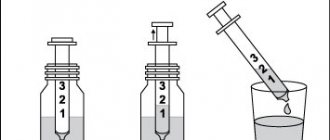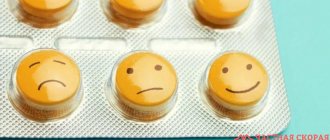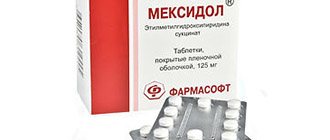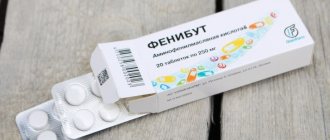RECOGNAN solution for oral administration 100 mg/ml 10 ml No. 10
Clinical-pharmacological group: Nootropic drug Pharmaco-therapeutic group: Nootropic drug Pharmacological action Citicoline, being a precursor of key ultrastructural components of the cell membrane (mainly phospholipids), has a wide spectrum of action: promotes the restoration of damaged cell membranes, inhibits the action of phospholipases, preventing the excessive formation of free radicals , as well as preventing cell death by affecting the mechanisms of apoptosis. In the acute period of stroke, it reduces the volume of damaged tissue and improves cholinergic transmission. In case of traumatic brain injury, it reduces the duration of post-traumatic coma and the severity of neurological symptoms, in addition, it helps to reduce the duration of the recovery period. Citicoline is effective in the treatment of cognitive, sensory and motor neurological disorders of degenerative and vascular etiology. In chronic cerebral ischemia, citicoline is effective in treating disorders such as memory impairment, lack of initiative, and difficulties in performing daily activities and self-care. Increases the level of attention and consciousness, and also reduces the manifestation of amnesia. Pharmacokinetics Absorption Citicoline is well absorbed when taken orally. Absorption after oral administration is almost complete, and bioavailability is approximately the same as after intravenous administration. After oral and parenteral administration, the concentration of choline in the blood plasma increases significantly. Distribution Citicoline is widely distributed in brain structures, with rapid incorporation of choline fractions into structural phospholipids and cytidine fractions into cytidine nucleotides and nucleic acids. Citicoline penetrates the brain and is actively incorporated into cellular, cytoplasmic and mitochondrial membranes, forming part of the fraction of structural phospholipids. Metabolism When administered intravenously and intramuscularly, citicoline is metabolized in the liver to form choline and cytidine. Excretion Only 15% of the administered dose of citicoline is excreted from the human body: less than 3% by the kidneys and intestines and about 12% by exhaled air. The excretion of citicoline in urine can be divided into 2 phases: a first phase, lasting about 36 hours, during which the rate of excretion decreases rapidly, and a second phase, during which the rate of excretion decreases much more slowly. The same is observed in exhaled air - the rate of elimination decreases rapidly after approximately 15 hours and then decreases much more slowly.
Recognan
Recognan oral solution 100 mg/ml x10 ATX code: N06BX06 (Citicoline)
Active substance: citicoline (citicoline) Rec.INN registered by WHO
Dosage form
RECOGNAN solution for oral administration 100 mg/ml: 10 ml sachets 5 or 10 pcs., vial. 30 ml 1 pc.
reg. No.: LP-003212 dated 09/22/15 - Valid
Release form, composition and packaging
Oral solution in the form of a clear pink liquid with a characteristic strawberry odor.
100 ml of citicoline monosodium salt 10.45 g, which corresponds to the content of citicoline 10 g
Excipients: sorbitol - 20 g, glycerol - 5 g, propylene glycol - 1.04 g, methyl parahydroxybenzoate - 0.16 mg, propyl parahydroxybenzoate - 0.04 mg, potassium sorbate - 0.14 g, sodium citrate dihydrate - 0.6 g, sodium saccharinate - 0.02 g, azorubine dye ( E122) - 0.0002 g, strawberry flavor FRESA S.1487S - 0.04 g, citric acid - up to pH 6.0, purified water - up to 100 ml.
10 ml - multilayer bags (5) - cardboard packs. 10 ml - multilayer sachets (10) - cardboard packs. 30 ml - glass bottles (1) with a dosing pipette - cardboard packs.
Clinical and pharmacological group: Nootropic drug
Pharmacotherapeutic group: Nootropic drug
Open the description of the active components of the drug RECOGNAN
The scientific information provided is general and cannot be used to make a decision about the possibility of using a particular drug.
pharmachologic effect
Pharmacokinetics
Indications
Ischemic stroke (acute period), ischemic and hemorrhagic stroke (recovery period), traumatic brain injury (acute and recovery period), cognitive impairment in degenerative and vascular diseases of the brain.
ICD-10 codes
Dosage regimen
When taken orally - 200-300 mg 3 times a day.
IV for strokes and traumatic brain injury in the acute period - 1-2 g/day, depending on the severity of the disease, for 3-7 days, followed by switching to IM administration or oral administration.
V/m - 0.5-1 g/day.
Side effect
From the central nervous system and peripheral nervous system: insomnia, headache, dizziness, agitation, tremor, numbness in paralyzed limbs.
From the digestive system: nausea, loss of appetite, changes in the activity of liver enzymes.
Allergic reactions: rash, itchy skin, anaphylactic shock.
Other: fever, in some cases - short-term hypotensive effect, stimulation of the parasympathetic nervous system.
Contraindications for use
Vagotonia (predominance of the tone of the parasympathetic part of the autonomic nervous system), childhood and adolescence up to 18 years, increased sensitivity to citicoline.
Use during pregnancy and breastfeeding
During pregnancy, use is possible only if the expected benefit of therapy for the mother outweighs the potential risk to the fetus.
If it is necessary to use citicoline during lactation, the issue of stopping breastfeeding should be decided, since there is no data on the excretion of citicoline in breast milk.
Use in children
Contraindicated in children and adolescents under 18 years of age.
special instructions
Citicoline should not be used concomitantly with medicinal products containing meclofenoxate.
Drug interactions
Citicoline enhances the effects of L-dihydroxyphenylalanine.
Buy Recognan solution intravenously and intramuscularly 1000 mg/4 ml ampoules 4 ml No. 5 in pharmacies
MINISTRY OF HEALTH OF THE RUSSIAN FEDERATION
INSTRUCTIONS FOR USE OF THE MEDICINE FOR MEDICAL USE
RECOGNAN®
Read these instructions carefully before you start taking/using this medicine. Save the instructions, you may need them again. If you have any questions, consult your doctor. This medicine is prescribed for you personally and should not be given to others because it may harm them even if they have the same symptoms as you.
Trade name : RECOGNAN®
International nonproprietary name : Citicoline
Dosage form: Solution for intravenous and intramuscular administration
Composition One ampoule of 500 mg in 4 ml contains the active substance: citicoline monosodium salt (citicoline sodium) 522.5 mg (equivalent to 500.0 mg of citicoline), excipients: hydrochloric acid or sodium hydroxide to pH 6.5 - 7.5; water for injection up to 4.0 ml.
One ampoule of 1000 mg in 4 ml contains the active substance: citicoline monosodium salt (citicoline sodium) 1045.0 mg (equivalent to 1000.0 mg citicoline) excipients: hydrochloric acid or sodium hydroxide to pH 6.5 - 7.5; water for injection up to 4.0 ml.
Description Transparent colorless liquid
Pharmacotherapeutic group: nootropic agent
ATX code: N06BX06
Pharmacological properties Pharmacodynamics Citicoline, being a precursor of key ultrastructural components of the cell membrane (mainly phospholipids), has a wide spectrum of action - it promotes the restoration of damaged cell membranes, inhibits the action of phospholipases, preventing the excessive formation of free radicals, and also preventing cell death by affecting the mechanisms of apoptosis. In the acute period of stroke, citicoline reduces the volume of brain tissue damage and improves cholinergic transmission. In case of traumatic brain injury, it reduces the duration of post-traumatic coma and the severity of neurological symptoms, in addition, it helps to reduce the duration of the recovery period. Citicoline is effective in the treatment of cognitive, sensory and motor neurological disorders of degenerative and vascular etiology. In chronic cerebral ischemia, citicoline is effective in treating disorders such as memory impairment, lack of initiative, and difficulties in performing daily activities and self-care. Increases the level of attention and consciousness, and also reduces the manifestation of amnesia.
Pharmacokinetics Metabolism When administered intravenously and intramuscularly, citicoline is metabolized in the liver to form choline and cytidine. After administration, the concentration of choline in the blood plasma increases significantly. Distribution Citicoline is widely distributed in brain structures, with rapid incorporation of choline fractions into structural phospholipids and cytidine fractions into cytidine nucleotides and nucleic acids. Citicoline penetrates the brain and is actively incorporated into cellular, cytoplasmic and mitochondrial membranes, forming part of the fraction of structural phospholipids. Excretion Only 15% of the administered dose of citicoline is excreted from the human body: less than 3% by the kidneys and intestines and about 12% by exhaled air. The excretion of citicoline in urine can be divided into 2 phases: a first phase, lasting about 36 hours, during which the rate of excretion decreases rapidly, and a second phase, during which the rate of excretion decreases much more slowly. The same is observed in exhaled air - the rate of elimination decreases rapidly after about 15 hours, and then decreases much more slowly.
Indications for use Acute period of ischemic stroke (as part of complex therapy), Recovery period of ischemic and hemorrhagic strokes, Traumatic brain injury (TBI), acute (as part of complex therapy) and recovery period, Cognitive and behavioral disorders in degenerative and vascular diseases of the brain brain
Contraindications It should not be prescribed to patients with vagotonia (predominance of the tone of the parasympathetic part of the autonomic nervous system) or with hypersensitivity to any of the components of the drug. Due to the lack of sufficient clinical data, it is not recommended for use in children under 18 years of age.
Use during pregnancy and breastfeeding There are no sufficient data on the use of citicoline in pregnant women. Although animal studies have not revealed any negative effects, during pregnancy the drug Recognan ® is prescribed only in cases where the expected benefit to the mother outweighs the potential risk to the fetus. When prescribing Recognan® during lactation, women should stop breastfeeding, since there is no data on the excretion of citicoline in human milk.
Method of administration and dosage The drug is prescribed intravenously or intramuscularly. Intravenously is prescribed in the form of a slow intravenous injection (over 3-5 minutes, depending on the prescribed dose) or intravenous drip (4060 drops per minute). The intravenous route of administration is preferable to the intramuscular route. When administered intramuscularly, repeated administration of the drug in the same place should be avoided. Recommended dosage regimen Acute period of ischemic stroke and traumatic brain injury (TBI): 1000 mg every 12 hours from the first day after diagnosis. The duration of treatment is at least 6 weeks. 3-5 days after the start of treatment (if swallowing function is not impaired), it is possible to switch to oral forms of the drug Recognan®. Recovery period of ischemic and hemorrhagic strokes, recovery period of head injury, cognitive and behavioral disorders in degenerative and vascular diseases of the brain: 500-2000 mg per day. Dosage and duration of treatment depending on the severity of the symptoms of the disease. It is possible to use oral forms of the drug Recognan®. Elderly patients: When prescribing Recognan® to elderly patients, no correction is required. The solution in the ampoule is intended for single use. It must be used immediately after opening the ampoule. The drug is compatible with all types of intravenous isotonic solutions and dextrose solutions.
Side effect Frequency of adverse reactions Very rare (<1/10000) (including individual cases): Allergic reactions (rash, itching, anaphylactic shock), headache, dizziness, feeling of heat, tremor, nausea, vomiting, diarrhea, hallucinations, swelling , shortness of breath, insomnia, agitation, loss of appetite, numbness in paralyzed limbs, changes in the activity of liver enzymes. In some cases, the drug can stimulate the parasympathetic system and also temporarily change blood pressure. If any of the side effects indicated in the instructions get worse, or any other side effects not listed in the instructions are noticed, you should inform your doctor.
Overdose Given the low toxicity of the drug, cases of overdose have not been described.
Interaction with other drugs Citicoline enhances the effects of levodopa. Should not be administered concomitantly with medicinal products containing meclofenoxate.
Special instructions Impact on the ability to drive vehicles and machinery During the treatment period, care should be taken when performing potentially hazardous activities that require increased special attention and speed of psychomotor reactions (driving a car and other vehicles, working with moving mechanisms, working as a dispatcher, operator, etc.) .P.).
Release forms Solution for intravenous and intramuscular administration 500 mg/4 ml, 1000 mg/4 ml. 4.0 ml in colorless glass ampoules of neutral glass (hydrolytic class I) with a stripe or break point. 5 ampoules per blister pack made of polyvinyl chloride film or polyvinyl chloride film and aluminum foil. One or two contour packages with instructions for use are placed in a box made of cardboard.
Storage conditions Store at a temperature not exceeding 25 0C. Keep out of the reach of children.
Shelf life: 3 years. Do not use after the expiration date indicated on the package.
Conditions of release Prescription release
Manufacturer 1. ALPHA WASSERMANN S.p.A., Italy, Pescara 2. FSUE "Moscow Endocrine Plant", Russia
Address of the manufacturer/place of production 1. 65020, Alanno Scano (Pescara), Via Enrico Fermi 1 2. 109052, Moscow, st. Novokhokhlovsksya, 25, building 1, building 2
Legal entity in whose name the registration certificate was issued/ Organization accepting claims GEROPHARM LLC, Russian Federation Legal address: 191119 St. Petersburg, st. Zvenigorodskaya, 9 Postal address: 191114, St. Petersburg, Degtyarny Lane, 11, lit. B Telephone (multi-channel), fax: (812) 103-79-76 Hotline telephone: 8-800-333-4376 (calls within Russia are free) www.geropharm.ru [email protected]
Recognan solution for intravenous and intramuscular administration 1000 mg/4 ml 4 ml x5
Recognan solution for intravenous and intramuscular injection 1000 mg/4 ml 4 ml x5 ATX code: N06BX06 (Citicoline)
Active substance: citicoline (citicoline) Rec.INN registered by WHO
Dosage form
RECOGNAN solution for intravenous and intramuscular administration 1000 mg/4 ml: amp. 5 or 10 pcs.
reg. No.: LP-003259 dated 10.20.15 - Valid
Release form, composition and packaging
The solution for intravenous and intramuscular administration is transparent, colorless.
1 amp. citicoline monosodium salt 1045 mg, which corresponds to the content of citicoline 1000 mg
Excipients: hydrochloric acid or sodium hydroxide - up to pH 6.5-7.5, water for injection - up to 4 ml.
4 ml - glass ampoules (5) - contour cell packaging (1) - cardboard packs. 4 ml - glass ampoules (5) - contour cell packaging (2) - cardboard packs.
Clinical and pharmacological group: Nootropic drug
Pharmacotherapeutic group: Nootropic drug
Open the description of the active components of the drug RECOGNAN
The scientific information provided is general and cannot be used to make a decision about the possibility of using a particular drug.
Indications
Ischemic stroke (acute period), ischemic and hemorrhagic stroke (recovery period), traumatic brain injury (acute and recovery period), cognitive impairment in degenerative and vascular diseases of the brain.
ICD-10 codes
Dosage regimen
When taken orally - 200-300 mg 3 times a day.
IV for strokes and traumatic brain injury in the acute period - 1-2 g/day, depending on the severity of the disease, for 3-7 days, followed by switching to IM administration or oral administration.
V/m - 0.5-1 g/day.
Side effect
From the central nervous system and peripheral nervous system: insomnia, headache, dizziness, agitation, tremor, numbness in paralyzed limbs.
From the digestive system: nausea, loss of appetite, changes in the activity of liver enzymes.
Allergic reactions: rash, itchy skin, anaphylactic shock.
Other: fever, in some cases - short-term hypotensive effect, stimulation of the parasympathetic nervous system.
Contraindications for use
Vagotonia (predominance of the tone of the parasympathetic part of the autonomic nervous system), childhood and adolescence up to 18 years, increased sensitivity to citicoline.
Use during pregnancy and breastfeeding
During pregnancy, use is possible only if the expected benefit of therapy for the mother outweighs the potential risk to the fetus.
If it is necessary to use citicoline during lactation, the issue of stopping breastfeeding should be decided, since there is no data on the excretion of citicoline in breast milk.
Use in children
Contraindicated in children and adolescents under 18 years of age.
special instructions
Citicoline should not be used concomitantly with medicinal products containing meclofenoxate.
Drug interactions
Citicoline enhances the effects of L-dihydroxyphenylalanine.






